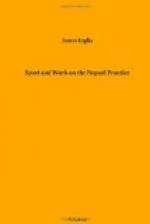Early in January, 1875, my camp was at a place in the sal jungles called Lohurneah. I had been collecting rents and looking after my seed cultivation, and Pat and our sporting District Engineer having joined me, we determined to have a beat for deer. Mehrman Singh had reported numerous herds in the vicinity of our camp. During the night we had been disturbed by the revellers at such a feast in the village as I have been describing. We had filled cartridges, seen to our guns, and made every preparation for the beat, and early in the morning the coolies and idlers of the forest villages all round were ranged in circles about our camp.
Swallowing a hasty breakfast we mounted our ponies, and followed by our ragged escort, made off for the forest. On the way we met a crowd of Banturs with bundles of stakes and great coils of strong heavy netting. Sending the coolies on ahead under charge of several headmen and peons, we plunged into the gloom of the forest, leaving our ponies and grooms outside. When we came to a likely-looking spot, the Banturs began operations by fixing up the nets on the stakes and between trees, till a line of strong net extended across the forest for several hundred yards. We then went ahead, leaving the nets behind us, and each took up his station about 200 yards in front. The men with the nets then hid themselves behind trees, and crouched in the underwood. With our kookries we cut down several branches, stuck them in the ground in front, and ensconced ourselves in this artificial shelter. Behind us, and between us and the nets, was a narrow cart track leading through the forest, and the reason of our taking this position was given me by Pat, who was an old hand at jungle shooting.
When deer are being driven, they are intensely suspicious, and of course frightened. They know every spot in the jungle, and are acquainted with all the paths, tracks, and open places in the forest. When they are nearing an open glade, or a road, they slacken their pace, and go slowly and warily forward, an old buck generally leading. When he has carefully reconnoitred and examined the suspected place in front, and found it clear to all appearance, they again put on the pace, and clear the open ground at their greatest speed. The best chance of a shot is when a path is in front of them and behind you, as then they are going slowly.




